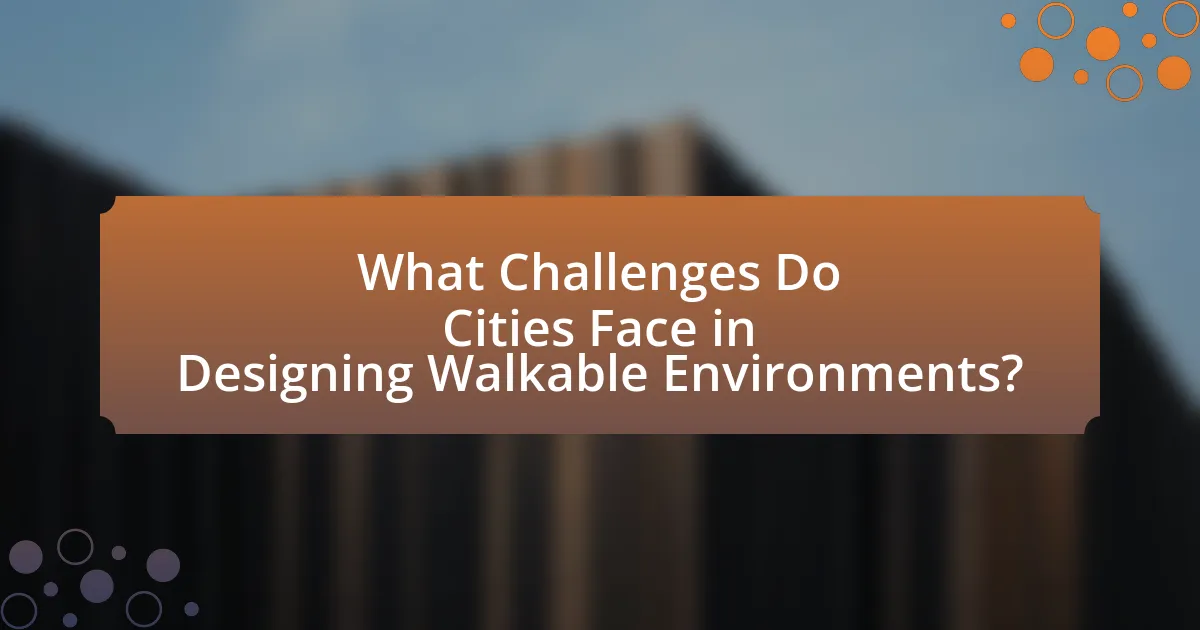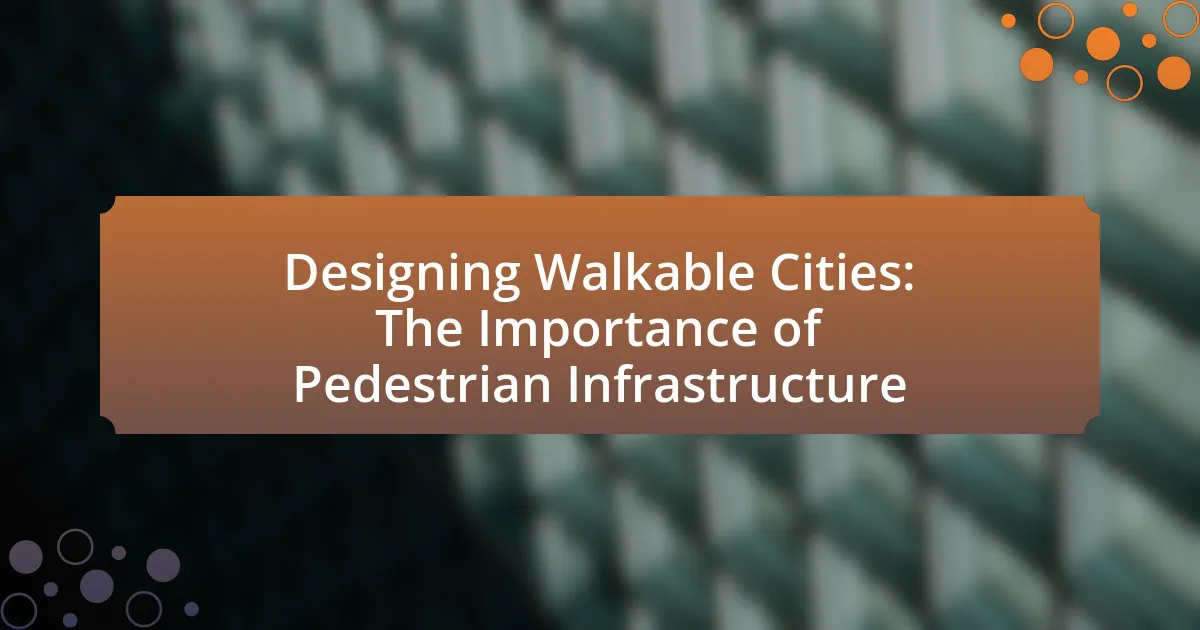Walkable cities are urban environments designed to prioritize pedestrian access and mobility, facilitating easy access to essential services and public spaces. This article explores the significance of walkable cities, highlighting their benefits for public health, community well-being, environmental sustainability, and economic vitality. Key topics include the role of pedestrian infrastructure in promoting health, enhancing social interaction, and reducing carbon footprints, as well as the economic advantages associated with walkable neighborhoods. Additionally, the article addresses challenges cities face in creating walkable environments and outlines best practices for effective pedestrian infrastructure design.

What are Walkable Cities and Why are They Important?
Walkable cities are urban areas designed to prioritize pedestrian access and mobility, enabling residents to easily walk to essential services, amenities, and public spaces. These cities are important because they promote healthier lifestyles, reduce reliance on automobiles, and contribute to environmental sustainability. Research indicates that walkable environments can lead to a 20-40% increase in physical activity among residents, which is linked to lower obesity rates and improved public health outcomes. Additionally, walkable cities often experience enhanced economic vitality, as businesses benefit from increased foot traffic and higher property values.
How do walkable cities enhance community well-being?
Walkable cities enhance community well-being by promoting physical activity, social interaction, and mental health. Research indicates that residents in walkable neighborhoods engage in more walking and cycling, leading to increased physical fitness and reduced obesity rates. A study published in the American Journal of Preventive Medicine found that individuals living in walkable areas are 35% more likely to meet recommended physical activity levels. Additionally, walkable cities foster social connections by providing public spaces where people can gather, which has been linked to lower levels of loneliness and improved mental health outcomes. The National Institute of Health highlights that social cohesion in walkable communities contributes to a sense of belonging and overall life satisfaction.
What role does pedestrian infrastructure play in promoting health?
Pedestrian infrastructure plays a crucial role in promoting health by facilitating physical activity and reducing reliance on motorized transportation. Well-designed sidewalks, crosswalks, and pedestrian pathways encourage walking, which is associated with numerous health benefits, including lower rates of obesity, cardiovascular disease, and improved mental health. Research indicates that communities with better pedestrian infrastructure see higher levels of walking and cycling; for example, a study published in the American Journal of Preventive Medicine found that residents in walkable neighborhoods engage in 35% more physical activity compared to those in less walkable areas. This correlation underscores the importance of investing in pedestrian-friendly environments to enhance public health outcomes.
How do walkable cities contribute to social interaction?
Walkable cities enhance social interaction by creating environments that encourage people to engage with one another in public spaces. The design of walkable cities, which includes pedestrian-friendly infrastructure such as sidewalks, parks, and communal areas, facilitates spontaneous encounters and conversations among residents. Research indicates that neighborhoods with higher walkability scores report increased social cohesion and community involvement, as evidenced by a study published in the Journal of Urbanism, which found that walkable areas promote more frequent social interactions and a stronger sense of belonging among residents.
What environmental benefits do walkable cities provide?
Walkable cities provide significant environmental benefits, including reduced greenhouse gas emissions and improved air quality. By promoting walking over driving, these urban areas decrease reliance on automobiles, which are major contributors to carbon emissions. For instance, a study by the Victoria Transport Policy Institute found that increasing walkability can reduce vehicle miles traveled by up to 30%, leading to lower emissions and less traffic congestion. Additionally, walkable cities often incorporate green spaces, which enhance biodiversity and help mitigate urban heat effects, further contributing to a healthier environment.
How does pedestrian infrastructure reduce carbon footprints?
Pedestrian infrastructure reduces carbon footprints by promoting walking as a primary mode of transportation, which decreases reliance on motor vehicles. When cities invest in sidewalks, crosswalks, and pedestrian zones, they create environments that encourage people to walk instead of drive. This shift leads to lower greenhouse gas emissions, as transportation accounts for approximately 29% of total U.S. greenhouse gas emissions, with personal vehicles being a significant contributor. Studies show that cities with robust pedestrian infrastructure experience a reduction in vehicle miles traveled, which directly correlates with decreased carbon emissions. For instance, a report from the National Association of City Transportation Officials indicates that improved walkability can lead to a 20-40% reduction in car trips, thereby significantly lowering carbon footprints.
What impact do walkable cities have on urban biodiversity?
Walkable cities positively impact urban biodiversity by promoting green spaces and reducing vehicle emissions. The design of walkable environments encourages the integration of parks, gardens, and natural habitats, which support various species. Research indicates that cities with higher walkability scores often have increased vegetation and wildlife presence, as seen in studies conducted in cities like Portland and Copenhagen, where urban planning prioritizes pedestrian access and green infrastructure. These factors contribute to healthier ecosystems and enhance the overall biodiversity within urban settings.
What economic advantages are associated with walkable cities?
Walkable cities provide significant economic advantages, including increased property values, enhanced local business revenues, and reduced transportation costs. Studies indicate that properties in walkable neighborhoods can command prices up to 30% higher than those in car-dependent areas, as demonstrated by research from the National Association of Realtors. Additionally, local businesses in walkable areas often experience a 20-40% increase in sales due to higher foot traffic, according to the Project for Public Spaces. Furthermore, residents in walkable cities save an average of $9,000 annually on transportation costs, as reported by the Victoria Transport Policy Institute, contributing to greater disposable income and economic activity within the community.
How does pedestrian infrastructure influence local businesses?
Pedestrian infrastructure positively influences local businesses by increasing foot traffic, which leads to higher sales. Studies show that areas with well-designed pedestrian pathways, sidewalks, and crossings experience a significant boost in customer visits. For instance, a report by the National Association of Realtors indicates that walkable neighborhoods can increase retail sales by 20 to 40 percent compared to car-dependent areas. Additionally, businesses located in pedestrian-friendly zones benefit from enhanced visibility and accessibility, attracting more customers who prefer walking over driving. This correlation between pedestrian infrastructure and business performance underscores the economic advantages of investing in walkable urban environments.
What are the cost savings related to walkable urban design?
Walkable urban design leads to significant cost savings by reducing transportation expenses, lowering infrastructure maintenance costs, and increasing property values. Studies indicate that walkable neighborhoods can decrease household transportation costs by up to 20% due to reduced reliance on cars. Additionally, cities with walkable designs often experience lower road maintenance costs, as fewer vehicles lead to less wear and tear on infrastructure. Furthermore, properties in walkable areas typically appreciate faster, with a 10-20% increase in value compared to less walkable neighborhoods, enhancing tax revenues for municipalities.

What Key Elements Constitute Effective Pedestrian Infrastructure?
Effective pedestrian infrastructure consists of well-designed sidewalks, safe crossings, adequate lighting, accessibility features, and amenities such as benches and shade. Well-designed sidewalks provide sufficient width and smooth surfaces to accommodate foot traffic, while safe crossings, including marked crosswalks and traffic signals, enhance safety for pedestrians. Adequate lighting improves visibility at night, reducing the risk of accidents. Accessibility features, such as curb cuts and tactile paving, ensure that all individuals, including those with disabilities, can navigate the environment. Amenities like benches and shade enhance the walking experience, encouraging more people to walk. Research indicates that cities with comprehensive pedestrian infrastructure see increased foot traffic and improved public health outcomes.
What types of pedestrian pathways are essential for walkability?
Essential types of pedestrian pathways for walkability include sidewalks, crosswalks, pedestrian-only streets, and multi-use paths. Sidewalks provide safe, designated areas for pedestrians to walk alongside roadways, reducing the risk of accidents. Crosswalks facilitate safe street crossings, often marked with signage and signals to enhance visibility and safety. Pedestrian-only streets eliminate vehicle traffic, creating safe zones for walking and social interaction. Multi-use paths accommodate both pedestrians and cyclists, promoting active transportation and connectivity. Research indicates that cities with well-designed pedestrian pathways experience higher foot traffic and improved public health outcomes.
How do sidewalks and crosswalks enhance pedestrian safety?
Sidewalks and crosswalks enhance pedestrian safety by providing designated spaces for walking and crossing streets, which reduces the likelihood of accidents. Sidewalks physically separate pedestrians from vehicular traffic, minimizing exposure to potential collisions. Crosswalks, marked areas for pedestrians to cross streets, increase visibility and alert drivers to the presence of pedestrians, further decreasing the risk of accidents. According to the Federal Highway Administration, well-designed crosswalks can reduce pedestrian crashes by up to 40%. This evidence supports the effectiveness of sidewalks and crosswalks in promoting safer pedestrian environments.
What role do pedestrian-only zones play in urban design?
Pedestrian-only zones play a crucial role in urban design by enhancing walkability and promoting sustainable transportation. These zones prioritize foot traffic over vehicular access, leading to reduced traffic congestion and improved air quality. Research indicates that cities with pedestrian-only areas experience increased economic activity, as foot traffic boosts local businesses. For instance, a study by the Victoria Transport Policy Institute found that pedestrian-friendly environments can increase retail sales by up to 40%. Additionally, pedestrian-only zones contribute to social interaction and community engagement, fostering vibrant public spaces that enhance the overall quality of urban life.
How does public transportation integrate with pedestrian infrastructure?
Public transportation integrates with pedestrian infrastructure by providing accessible transit stops that are designed to facilitate easy movement for pedestrians. This integration is crucial for enhancing urban mobility, as it allows individuals to transition seamlessly between walking and using public transport. For example, cities like Copenhagen have implemented wide sidewalks, safe crosswalks, and dedicated bike lanes near bus and train stations, which encourages walking and cycling as part of the overall transportation network. Studies show that areas with well-integrated public transport and pedestrian infrastructure experience increased foot traffic and improved safety, leading to higher public transport usage and reduced reliance on cars.
What are the benefits of transit-oriented development?
Transit-oriented development (TOD) offers numerous benefits, primarily enhancing accessibility and reducing reliance on automobiles. By concentrating housing, jobs, and services near public transit hubs, TOD promotes increased public transport usage, which can lead to lower traffic congestion and reduced greenhouse gas emissions. Studies indicate that areas with TOD experience a 20-40% increase in public transit ridership compared to conventional developments. Additionally, TOD fosters economic growth by attracting businesses and increasing property values, as seen in cities like Portland, Oregon, where property values near transit stations have risen significantly. Furthermore, TOD contributes to improved public health by encouraging walking and cycling, thereby promoting active lifestyles.
How can cities improve access to public transport for pedestrians?
Cities can improve access to public transport for pedestrians by enhancing connectivity through well-designed pedestrian pathways and safe crossings. Implementing features such as wider sidewalks, dedicated pedestrian zones, and clear signage facilitates easier navigation to transport hubs. For instance, cities like Copenhagen have integrated extensive bike lanes and pedestrian-friendly streets, resulting in a 62% increase in public transport usage. Additionally, ensuring that public transport stops are located within a short walking distance from residential areas can significantly boost accessibility, as evidenced by studies showing that proximity to transit options increases ridership by up to 30%.
What design features improve the pedestrian experience?
Design features that improve the pedestrian experience include wide sidewalks, safe crossings, and adequate lighting. Wide sidewalks accommodate more foot traffic and allow for comfortable movement, while safe crossings, such as marked crosswalks and pedestrian signals, enhance safety and encourage walking. Adequate lighting increases visibility at night, making pedestrians feel safer and more secure. Research indicates that cities with these features experience higher pedestrian activity and lower accident rates, demonstrating their effectiveness in enhancing the overall pedestrian experience.
How do street furniture and landscaping contribute to walkability?
Street furniture and landscaping significantly enhance walkability by creating inviting and comfortable environments for pedestrians. Well-placed benches, trash receptacles, and bike racks encourage people to walk by providing necessary amenities, while landscaping elements like trees and plants improve aesthetic appeal and offer shade, making walking more pleasant. Research indicates that urban areas with ample street furniture and greenery see increased foot traffic; for example, a study by the National Association of City Transportation Officials found that streets with trees can increase pedestrian activity by up to 20%. This evidence underscores the critical role that street furniture and landscaping play in promoting walkable urban spaces.
What is the significance of lighting and signage for pedestrians?
Lighting and signage are crucial for pedestrian safety and navigation. Adequate lighting enhances visibility, reducing the risk of accidents and crime, while clear signage provides essential information about directions, crossings, and hazards. Studies show that well-lit areas can decrease crime rates by up to 20%, and effective signage can improve pedestrian compliance with traffic rules, leading to safer walking environments.

What Challenges Do Cities Face in Designing Walkable Environments?
Cities face several challenges in designing walkable environments, including inadequate infrastructure, mixed land use, and safety concerns. Inadequate infrastructure often results from a lack of sidewalks, crosswalks, and pedestrian-friendly amenities, which can discourage walking. Mixed land use is essential for creating vibrant neighborhoods, but zoning regulations may limit the integration of residential, commercial, and recreational spaces, making it difficult for residents to access services without a vehicle. Safety concerns, such as traffic speed and crime rates, can deter pedestrians, as high-speed roads and poorly lit areas create an unwelcoming environment. These challenges necessitate comprehensive planning and community engagement to create effective pedestrian infrastructure.
What common obstacles hinder the development of pedestrian infrastructure?
Common obstacles that hinder the development of pedestrian infrastructure include insufficient funding, lack of political will, and competing land use priorities. Insufficient funding often results from budget constraints at local and state levels, limiting the ability to invest in necessary infrastructure. Lack of political will can stem from a focus on automobile-centric policies, which prioritize road expansion over pedestrian-friendly designs. Competing land use priorities arise when urban planning favors commercial or residential development over the allocation of space for sidewalks, crosswalks, and other pedestrian amenities. These factors collectively impede the creation of safe and accessible walking environments in urban areas.
How do budget constraints affect walkability initiatives?
Budget constraints significantly limit the scope and effectiveness of walkability initiatives. When funding is restricted, municipalities often prioritize essential services over pedestrian infrastructure, leading to inadequate investment in sidewalks, crosswalks, and public spaces that promote walking. For instance, a study by the National Complete Streets Coalition found that cities with limited budgets frequently defer maintenance and improvements on pedestrian facilities, resulting in unsafe walking conditions and reduced accessibility. This lack of investment can hinder community health, economic vitality, and overall quality of life, as walkable environments are linked to increased physical activity and reduced traffic congestion.
What role does urban sprawl play in limiting walkable spaces?
Urban sprawl significantly limits walkable spaces by promoting low-density development that separates residential, commercial, and recreational areas. This separation increases reliance on automobiles, as distances between destinations become too great for walking. According to the Smart Growth America report, areas characterized by urban sprawl have fewer sidewalks and pedestrian-friendly infrastructure, which discourages walking and reduces accessibility. Consequently, urban sprawl contributes to a built environment that is not conducive to pedestrian movement, ultimately diminishing the availability of walkable spaces.
How can cities overcome resistance to walkable design?
Cities can overcome resistance to walkable design by engaging communities in the planning process and demonstrating the benefits of walkability. Involving residents through workshops and surveys fosters a sense of ownership and addresses concerns directly. Studies show that walkable neighborhoods can increase property values by 10-20% and reduce transportation costs, making them economically appealing. Additionally, cities can implement pilot projects that showcase walkable features, allowing residents to experience the benefits firsthand, which can shift public perception positively.
What strategies can be employed to engage community stakeholders?
To engage community stakeholders effectively, strategies such as inclusive public meetings, surveys, and collaborative workshops can be employed. These methods facilitate open dialogue, allowing stakeholders to voice their concerns and ideas regarding pedestrian infrastructure. Research indicates that involving community members in the planning process increases project acceptance and success rates, as seen in the case of the 2016 “Walkable Communities” initiative in Portland, which resulted in a 30% increase in pedestrian satisfaction.
How can cities educate the public on the benefits of walkability?
Cities can educate the public on the benefits of walkability through targeted awareness campaigns and community engagement initiatives. These efforts can include workshops, informational signage, and social media outreach that highlight the health, environmental, and economic advantages of walkable neighborhoods. For instance, studies show that walkable areas can reduce obesity rates by promoting physical activity, as evidenced by research from the American Journal of Preventive Medicine, which found that residents in walkable neighborhoods engage in more daily walking. Additionally, cities can implement pilot programs that demonstrate walkability improvements, allowing residents to experience the benefits firsthand, thereby reinforcing the positive impacts of pedestrian-friendly infrastructure.
What are the best practices for designing walkable cities?
The best practices for designing walkable cities include creating mixed-use developments, ensuring safe and accessible pedestrian pathways, and incorporating green spaces. Mixed-use developments promote proximity between residential, commercial, and recreational areas, which encourages walking. Safe and accessible pedestrian pathways, including well-maintained sidewalks and crosswalks, reduce accidents and enhance mobility. Incorporating green spaces, such as parks and tree-lined streets, improves the aesthetic appeal and provides resting areas, making walking more enjoyable. Research from the National Complete Streets Coalition indicates that walkable environments lead to increased physical activity and reduced traffic-related injuries, supporting the effectiveness of these practices.
How can cities implement successful pedestrian infrastructure projects?
Cities can implement successful pedestrian infrastructure projects by prioritizing comprehensive planning, community engagement, and evidence-based design. Comprehensive planning involves assessing existing pedestrian needs and integrating them into urban development plans, ensuring that infrastructure aligns with the city’s overall goals. Community engagement is crucial; cities should involve residents in the planning process to gather input and foster support, as seen in cities like Copenhagen, where public consultations led to the successful redesign of streets for pedestrians. Evidence-based design utilizes data on pedestrian traffic patterns and safety statistics to inform decisions, such as the implementation of wider sidewalks and pedestrian-only zones, which have been shown to reduce accidents and increase foot traffic, as evidenced by studies from the National Association of City Transportation Officials.
What lessons can be learned from cities that excel in walkability?
Cities that excel in walkability demonstrate the importance of mixed-use development, pedestrian-friendly infrastructure, and accessible public spaces. These cities, such as Copenhagen and Amsterdam, prioritize the integration of residential, commercial, and recreational areas, which encourages walking as a primary mode of transportation. Research indicates that walkable cities experience lower traffic congestion and higher levels of physical activity among residents, contributing to overall public health. For instance, a study by the Victoria Transport Policy Institute found that walkable neighborhoods can reduce vehicle miles traveled by up to 30%. Additionally, effective urban design elements, such as wide sidewalks, safe crossings, and ample green spaces, enhance the walking experience and promote community interaction.
